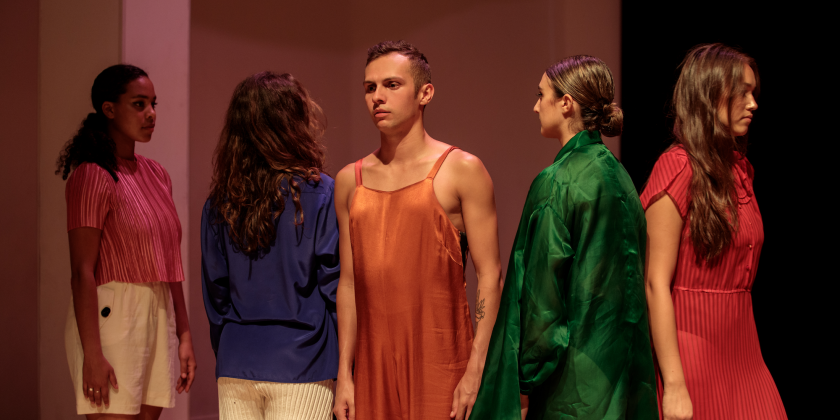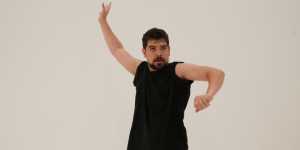IMPRESSIONS: HOLDTIGHT Company's "What Keeps You Going" at the cell theatre

September 19, 2021
Conception: Gwendolyn Gussman
Performance: Johnny Butler, Dervla Carey-Jones, Nico Gonzales, Gwendolyn Gussman, Emily Haughton, Xenia Mansour
Music and sound: Johnny Butler // Scenography: Anna Driftmier
Lighting Design: Aja M. Jackson // Technical Director: Alex Taylor
There’s being put on the spot, and then there’s answering a deep philosophical question right after you’ve entered the theater, breathless and changing (metaphorical) hats from aggravated pedestrian to dance critic. “Why do you care?” asks Nico Gonzales as Xenia Mansour records my answer on an old-fashioned tape deck. “Uh?” I respond before mumbling something that belongs inside a stale fortune cookie. This is the quasi start to HOLDTIGHT Company’s premiere of What Keeps You Going.
The question frames the piece although I (and maybe the other thirteen showgoers) wish I’d said something smarter, more profound. No matter. The question will resound through the ninety-minute, multimedia, dance-theater work as I (and maybe everyone else) redefine my answer. That answer swells and then shrinks, alters and then falters, as we play bystander to first-person narratives, gravity-succumbing movement, and original music by Johnny Butler that ranges from gentle piano melodies to a virtuosic saxophone solo.

All this occurred at the cell theatre, which looks nothing like your typical barebones, plain-Jane theater that houses experimental live arts. This is a sumptuous townhouse in Chelsea with exquisite crown molding, grand fireplaces, and glossy wood floors, like a setting for a Henry James’ novel.
Artistic director Gwendolyn Gussman exploits the possibilities of the theater’s multiple, multi-purpose rooms. Divided into two groups, the audience troops from the main performing area with its heap of spongy brown shards to a mezzanine-level video installation of blinking eyes, and then up to the second floor containing a front and back parlor. Be warned: stairs will be climbed, and a fair amount of standing will occur. Nothing, though, exceeds what you’d experience in a New York subway station.

Five dancer-actors and one musician-composer take turns in the figurative spotlight. Gonzalez relates his familial tendency to vulnerability, a trait nurtured by his parents. His mother, he says, still picks up litter when she visits New York City. Emily Haughton talks about her younger sister, who had issues with depth perception, which kept her reticent, unlike blank, who could be outgoing. Mansour self-flagellates through a blistering, whirling solo, her shadow looming ominously on the white wall behind her. These Millennials are frustrated, they are conflicted, and they are trying to figure out, Gussman explains, the balance between ease and effort. Told through text, sound, video, and movement, their tales accrue in heft and texture as they weave into one story of reconciling hopes with reality.
It’s not all personal yarns, though. It’s about existing New York, a city that’ll grant you all you wish—if you can survive its incessant demands. Gonzalez has tamped down on his empath nature, which flattens his formerly heightened emotions. Gussman ponders how she should spend her hours: she could teach more Pilates, or she could spend more time with her partner. As her options increase, so does the futility of identifying the best choice in a place where trying to make it while making the rent may just break your spirit.

But it’s not just about them and what they want because others want what they want, too. In an early vignette, dancers pace a few steps and then swivel. Soon, pathways end behind someone, then intersect, and before you know it, they’re brawling as one person’s desire smacks into another’s. The central pile of what resembles chocolate shavings is strewn across the space as performers fight over how to organize it (lines or curves). Is there a winner when you’re only as good as your argument? Doubtful.
Yet in the culmination, catharsis and, perhaps, an answer have asserted themselves. To a twinkling, soul-elevating score, the cast comes together, bodies entwining with other bodies. A recording of our collective answers about why we care blares through a tape deck. We ponder our words then and the ones we’d say now. After all, we’ve been the witness to why they care and how they keep going, even when it hurts and it’s hard. So why do you care?















